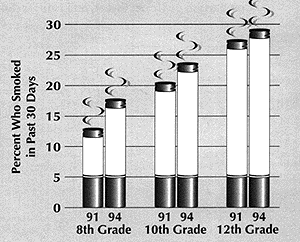Daughters of Mothers Who Smoked During Pregnancy are More Likely to Smoke, Study Says
Download PDF Version What is PDF?
Robert Mathias
Robert Mathias is a Staff Writer for NIDA NOTES.
Source: NIDA NOTES, Vol. 10, No. 5, September/October, 1995
Public Domain
Table of Contents (TOC)
Article: Daughters of Mothers Who Smoked During Pregnancy are More Likely to Smoke, Study SaysReferences
Researchers have long wondered about the impact of prenatal exposure to drugs on a child’s vulnerability to drug abuse. Now, NIDA-funded studies have documented a relationship between prenatal exposure to nicotine and adolescents’ use of tobacco. Dr. Denise Kandel of Columbia University found that daughters of women who smoked cigarettes while they were pregnant are four times more likely to begin smoking during adolescence and to continue smoking than daughters of women who did not smoke during pregnancy.
 "The clearest message from the study is that mothers should
not smoke during pregnancy," says Dr. Kandel. The study
suggests that nicotine, which crosses the placental barrier,
may affect the female fetus during an important period of
development so as to predispose the brain to the addictive
influence of nicotine more than a decade later, she says.
"The clearest message from the study is that mothers should
not smoke during pregnancy," says Dr. Kandel. The study
suggests that nicotine, which crosses the placental barrier,
may affect the female fetus during an important period of
development so as to predispose the brain to the addictive
influence of nicotine more than a decade later, she says.
Prenatal smoking by these mothers did not have a strong effect on their sons’ smoking, but it is not clear why, says Dr. Kandel. Male hormones or structural differences of male and female brains may protect the developing male fetus from the nicotine entering the brain, she says, but notes, "That is all very speculative."
Prenatal exposure to smoking has previously been linked with impairments in memory, learning, cognition, and perception in the growing child, says Dr. Jagjitsing Khalsa of NIDA’s Division of Clinical and Services Research. The results of Dr. Kandel’s study suggest that smoking during pregnancy may create a risk of early and continued smoking among these women’s children, he says. Noting that other NIDA researchers are looking at the possible intergenerational transmission of a tendency to use marijuana through prenatal exposure, Dr. Khalsa says, "We need to let women know that if they take drugs during pregnancy they may put their offspring at risk for future drug use."

Source: NIDA’s Monitoring the Future Studies, 1991-94
According
to NIDA’s Monitoring the Future Study, the percent of
adolescent girls who smoke cigarettes has increased in the
last 4 years.
Although smoking among adolescent girls has been linked to many different
factors, Dr. Kandel’s study is the first to document a possible link between
prenatal exposure to nicotine and an adolescent girl’s tendency to smoke cigarettes
In previous research, Dr. Kandel had examined the intergenerational effects of drug use by following a cohort of New York State adolescents who were periodically reinterviewed over the course of 19 years. That research indicated that a mother’s cigarette smoking had a greater effect than a father’s on smoking among both sons and daughters. When analyses of different social influences could not identify the reason for this maternal effect, Dr. Kandel focused on one factor that differentiated mothers from fathers-a mother’s smoking during pregnancy.
 In her most recent study, Dr. Kandel analyzed followup
interview data on 192 mothers and their first-born adolescents
from the New York State study. The children’s mean age was
12 1/2. The analysis revealed that 26.4 percent of girls
whose mothers smoked while pregnant had smoked in the last
year. By comparison, only 4.3 percent of girls who were
not prenatally exposed to nicotine had smoked in the last
year. While more prenatally exposed boys had also smoked
in the last year compared with boys whose mothers had not
smoked during pregnancy, the difference was not statistically
significant.
In her most recent study, Dr. Kandel analyzed followup
interview data on 192 mothers and their first-born adolescents
from the New York State study. The children’s mean age was
12 1/2. The analysis revealed that 26.4 percent of girls
whose mothers smoked while pregnant had smoked in the last
year. By comparison, only 4.3 percent of girls who were
not prenatally exposed to nicotine had smoked in the last
year. While more prenatally exposed boys had also smoked
in the last year compared with boys whose mothers had not
smoked during pregnancy, the difference was not statistically
significant.
Subsequently, Dr. Kandel replicated her New York State analysis with pre- and postnatal smoking data on 797 mothers and their children drawn from the National Longitudinal Survey of the Work Experience of Youth Cohort, a Bureau of Labor Statistics survey that has been conducted annually since 1979. The second analysis confirmed the findings from the New York State survey, says Dr. Kandel. The combined data from both surveys indicated a fourfold greater risk of smoking for girls whose mothers smoked during pregnancy.
To ensure that it was a mother’s prenatal smoking and not her postnatal smoking that affected her daughter’s smoking, the researchers analyzed the impact of those mothers’ smoking both during and after pregnancy. They found that, regardless of the amount or duration of current or past maternal smoking, the strongest correlation between maternal smoking and a daughter’s smoking occurred when the mother smoked during pregnancy.
Smoking activates several brain neurotransmitter systems including the dopamine system, which is involved in the reinforcing effects of addictive drugs in general, points out Dr. Kandel. Since this study raises the possibility that nicotine may modify the developing fetus’s dopamine system, making it more susceptible to the effects of nicotine at a later time in life, "The children whose mothers smoked during pregnancy are not only going to be more likely to smoke, but also may be more likely to use and become dependent on other drugs," she predicts. Dr. Kandel hopes to research this issue by following the adolescents in her study for another 6 years.
Kandel, D.B.; Wu, P.; and Davies, M. Maternal smoking during pregnancy and smoking by adolescent daughters. American Journal of Public Health 84(9):1407-1413, 1994.


